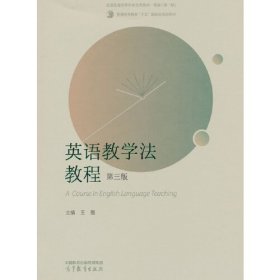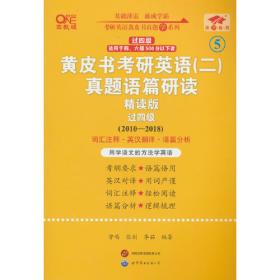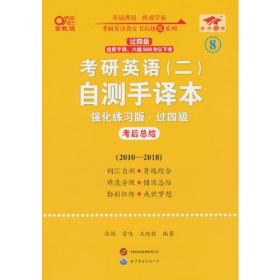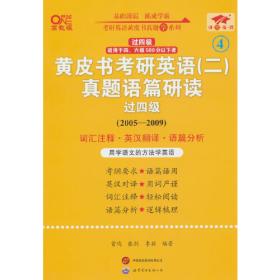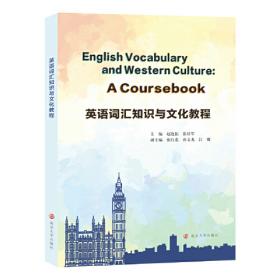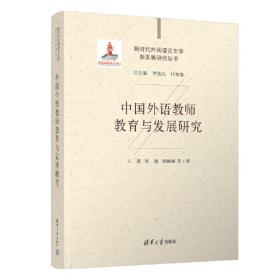英语教学法教程(第三版)
出版时间:
2024-04
版次:
3
ISBN:
9787040617726
定价:
68.00
装帧:
其他
开本:
16开
纸张:
胶版纸
页数:
396页
字数:
610.000千字
1人买过
-
《英语教学法教程(第三版)》修订工作是在党的二十大精神的指引下,全面融入《普通高中英语课程标准(2017年版)》和《义务教育英语课程标准(2022年版)》的新理念和新目标,重点探讨课程理念和课程目标的变化、课程内容的重组、学业质量要求和教学方式及评价方式的更新,以更好地培养适应国家改革发展新要求的人才。
本次修订针对每个章节都增加了新的要点,优化了活动设计,补充、替换了部分案例和阅读材料。删减了第二版教程中三个单元的内容:Unit 13(Integrated Skills), Unit 16 (Learner Differences and Learner Training) 和 Unit 18(Adapting and Evaluating Textbooks)。第三版教程共包含15个单元和开篇的导学部分。 前辅文
Getting Started
UNIT 1 Language and Language Learning
1.1 How do we learn languages?
1.2 Views on language
1.3 Views on language learning and learning in general
1.4 Conclusion
UNIT 2 Language Teaching Approaches and Methods
2.1 What roles do methods play in language teaching?
2.2 What do we know about the communicative language teaching?
2.3 What do we know about task-based language teaching?
2.4 The fit of CLT and TBLT in the Chinese context
2.5 Conclusion
UNIT 3 The National English Curricula
3.1 A brief history of foreign language teaching in China before 2000
3.2 An overview of English curriculum change after 2000
3.3 Core competency-based English curricula from 2018 onward
3.4 Challenges facing English language teachers
3.5 Conclusion
UNIT 4 Instructional Design
4.1 What is instructional design?
4.2 Why is instructional design important?
4.3 What are the general principles for an instructional design?
4.4 Why do we need both macro and micro plannings?
4.5 What is a unit design?
4.6 Why using big ideas in a unit design?
4.7 What components are normally included in a lesson plan?
4.8 Conclusion
UNIT 5 Classroom Management
5.1 The role of the teacher
5.2 Classroom instructions
5.3 Student grouping
5.4 Discipline in the language classroom
5.5 Questioning in the classroom
5.6 Dealing with errors
5.7 Conclusion
UNIT 6 Teaching Pronunciation
6.1 The role of pronunciation
6.2 The goal of teaching pronunciation
6.3 Aspects of pronunciation
6.4 Practising sounds
6.5 Practising stress and intonation
6.6 Conclusion
UNIT 7 Teaching Grammar
7.1 The role of grammar in language teaching
7.2 What is grammar about?
7.3 Grammar presentation
7.4 Grammar practice
7.5 Conclusion
UNIT 8 Teaching Vocabulary
8.1 Understanding vocabulary and vocabulary learning
8.2 What does knowing a word involve?
8.3 Ways of presenting vocabulary
8.4 Ways of consolidating vocabulary
8.5 Developing vocabulary learning strategies
8.6 Conclusion
UNIT 9 Teaching Listening
9.1 Why does listening seem so difficult?
9.2 What do we listen to in everyday life?
9.3 Characteristics of the listening process
9.4 Principles and models for teaching listening
9.5 Stages of teaching listening
9.6 Conclusion
UNIT 10 Teaching Speaking
10.1 Differences between spoken and written language
10.2 Principles for teaching speaking
10.3 Designing speaking tasks
10.4 Types of speaking tasks
10.5 Organising speaking tasks
10.6 Conclusion
UNIT 11 Teaching Reading
11.1 Reflecting on your own reading experiences
11.2 How do we read?
11.3 What do we read?
11.4 Strategies involved in reading comprehension
11.5 The role of vocabulary in reading
11.6 Principles for teaching reading
11.7 Models for teaching reading
11.8 Stages of teaching reading
11.9 Conclusion
UNIT 12 Teaching Writing
12.1 What, why and how do we write?
12.2 A communicative approach to writing
12.3 Problems in writing tasks
12.4 A Process Approach to writing
12.5 Motivating and enabling students to write
12.6 Designing writing tasks
12.7 Integrating reading and writing
12.8 Using the Internet to promote process writing
12.9 Conclusion
UNIT 13 Moral Learning
13.1 Moral learning and English
13.2 Activities for moral learning
13.3 The roles of the teacher
13.4 The roles of the school
13.5 Conclusion
UNIT 14 Assessment in Language Teaching
14.1 Understanding assessment
14.2 Assessment purposes
14.3 Summative and formative assessment
14.4 Assessment for learning
14.5 Methods of assessment
14.6 Criteria for assessment
14.7 Assessment principles
14.8 Tests in language assessment
14.9 Conclusion
UNIT 15 Use of Resources and Educational Technology
15.1 Resources available for teaching
15.2 Creating your own resources
15.3 Exploring hidden resources
15.4 Making use of multi-media resources
15.5 Conclusion
Appendixes
-
内容简介:
《英语教学法教程(第三版)》修订工作是在党的二十大精神的指引下,全面融入《普通高中英语课程标准(2017年版)》和《义务教育英语课程标准(2022年版)》的新理念和新目标,重点探讨课程理念和课程目标的变化、课程内容的重组、学业质量要求和教学方式及评价方式的更新,以更好地培养适应国家改革发展新要求的人才。
本次修订针对每个章节都增加了新的要点,优化了活动设计,补充、替换了部分案例和阅读材料。删减了第二版教程中三个单元的内容:Unit 13(Integrated Skills), Unit 16 (Learner Differences and Learner Training) 和 Unit 18(Adapting and Evaluating Textbooks)。第三版教程共包含15个单元和开篇的导学部分。
-
目录:
前辅文
Getting Started
UNIT 1 Language and Language Learning
1.1 How do we learn languages?
1.2 Views on language
1.3 Views on language learning and learning in general
1.4 Conclusion
UNIT 2 Language Teaching Approaches and Methods
2.1 What roles do methods play in language teaching?
2.2 What do we know about the communicative language teaching?
2.3 What do we know about task-based language teaching?
2.4 The fit of CLT and TBLT in the Chinese context
2.5 Conclusion
UNIT 3 The National English Curricula
3.1 A brief history of foreign language teaching in China before 2000
3.2 An overview of English curriculum change after 2000
3.3 Core competency-based English curricula from 2018 onward
3.4 Challenges facing English language teachers
3.5 Conclusion
UNIT 4 Instructional Design
4.1 What is instructional design?
4.2 Why is instructional design important?
4.3 What are the general principles for an instructional design?
4.4 Why do we need both macro and micro plannings?
4.5 What is a unit design?
4.6 Why using big ideas in a unit design?
4.7 What components are normally included in a lesson plan?
4.8 Conclusion
UNIT 5 Classroom Management
5.1 The role of the teacher
5.2 Classroom instructions
5.3 Student grouping
5.4 Discipline in the language classroom
5.5 Questioning in the classroom
5.6 Dealing with errors
5.7 Conclusion
UNIT 6 Teaching Pronunciation
6.1 The role of pronunciation
6.2 The goal of teaching pronunciation
6.3 Aspects of pronunciation
6.4 Practising sounds
6.5 Practising stress and intonation
6.6 Conclusion
UNIT 7 Teaching Grammar
7.1 The role of grammar in language teaching
7.2 What is grammar about?
7.3 Grammar presentation
7.4 Grammar practice
7.5 Conclusion
UNIT 8 Teaching Vocabulary
8.1 Understanding vocabulary and vocabulary learning
8.2 What does knowing a word involve?
8.3 Ways of presenting vocabulary
8.4 Ways of consolidating vocabulary
8.5 Developing vocabulary learning strategies
8.6 Conclusion
UNIT 9 Teaching Listening
9.1 Why does listening seem so difficult?
9.2 What do we listen to in everyday life?
9.3 Characteristics of the listening process
9.4 Principles and models for teaching listening
9.5 Stages of teaching listening
9.6 Conclusion
UNIT 10 Teaching Speaking
10.1 Differences between spoken and written language
10.2 Principles for teaching speaking
10.3 Designing speaking tasks
10.4 Types of speaking tasks
10.5 Organising speaking tasks
10.6 Conclusion
UNIT 11 Teaching Reading
11.1 Reflecting on your own reading experiences
11.2 How do we read?
11.3 What do we read?
11.4 Strategies involved in reading comprehension
11.5 The role of vocabulary in reading
11.6 Principles for teaching reading
11.7 Models for teaching reading
11.8 Stages of teaching reading
11.9 Conclusion
UNIT 12 Teaching Writing
12.1 What, why and how do we write?
12.2 A communicative approach to writing
12.3 Problems in writing tasks
12.4 A Process Approach to writing
12.5 Motivating and enabling students to write
12.6 Designing writing tasks
12.7 Integrating reading and writing
12.8 Using the Internet to promote process writing
12.9 Conclusion
UNIT 13 Moral Learning
13.1 Moral learning and English
13.2 Activities for moral learning
13.3 The roles of the teacher
13.4 The roles of the school
13.5 Conclusion
UNIT 14 Assessment in Language Teaching
14.1 Understanding assessment
14.2 Assessment purposes
14.3 Summative and formative assessment
14.4 Assessment for learning
14.5 Methods of assessment
14.6 Criteria for assessment
14.7 Assessment principles
14.8 Tests in language assessment
14.9 Conclusion
UNIT 15 Use of Resources and Educational Technology
15.1 Resources available for teaching
15.2 Creating your own resources
15.3 Exploring hidden resources
15.4 Making use of multi-media resources
15.5 Conclusion
Appendixes
查看详情
-
全新
上海市浦东新区
平均发货23小时
成功完成率89.47%
-
全新
江苏省南京市
平均发货13小时
成功完成率85.39%
-
英语教学法教程(第三版)
新华书店全新正版书籍。书名与图片不一致的,以书名为准。个别套装书为单本价格,详情请咨询客服下单。
全新
河北省沧州市
平均发货14小时
成功完成率70.05%
-
全新
广东省广州市
平均发货11小时
成功完成率85.42%
-
全新
广东省广州市
平均发货11小时
成功完成率88.99%

 占位居中
占位居中




